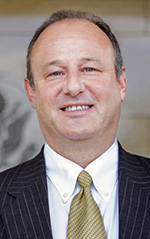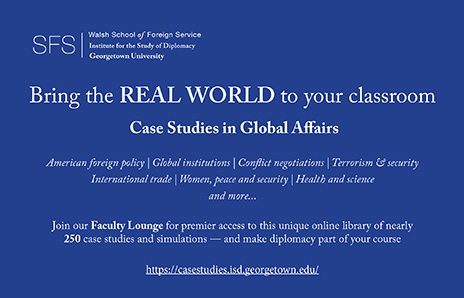A Time of Hope and Optimism
The stunning fall of the Berlin Wall in November 1989 heralded a series of events that transformed the postwar world. Here is a view from Washington.
BY ERIC RUBIN
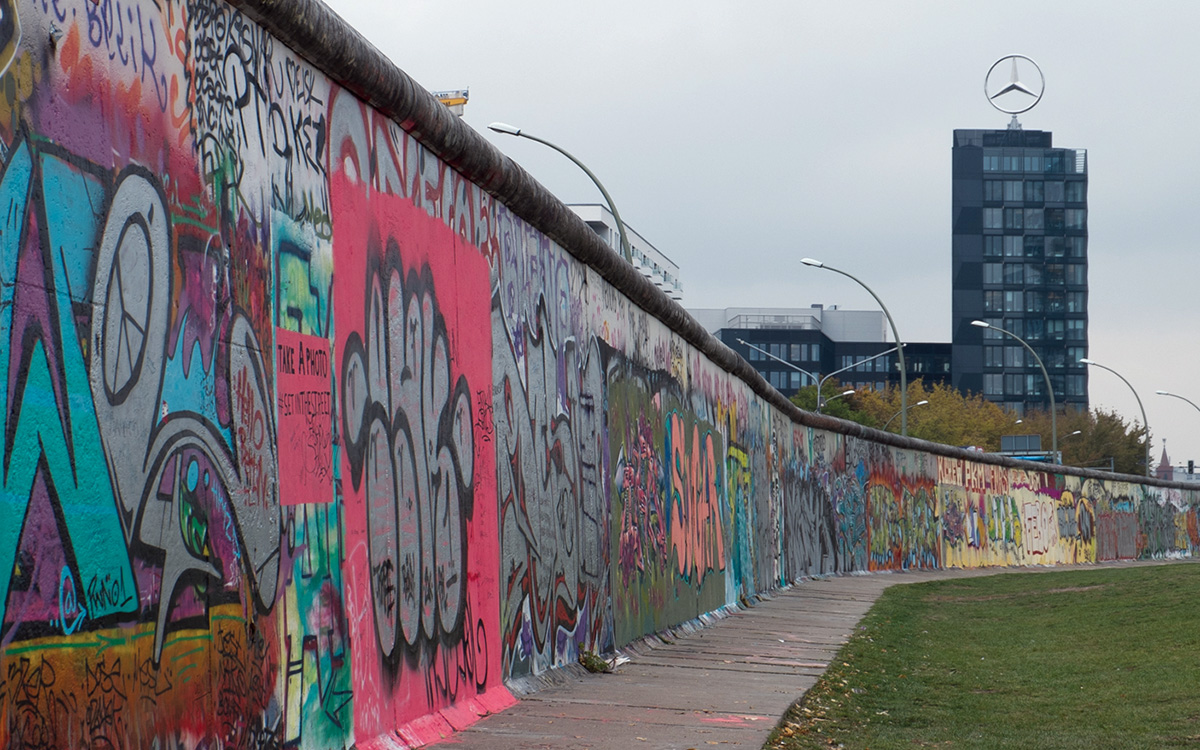
Berlin Wall Photo by James Talalay
I joined the Soviet Desk in February 1989 after a year as a watch officer in the State Department Operations Center. I quickly realized that I was joining a dream team. It was the largest single-country office in the department by far, divided into three divisions: bilateral affairs, multilateral affairs and economic affairs. I was assigned to “bilat,” as we called it. I was thrilled: I had studied Russian in high school in 1977 and continued through college. I knew I wanted to go to the Soviet Union as soon as possible, but for my first tour, I was sent to Honduras where I had the opportunity to learn Spanish.
My portfolio on the Soviet Desk was fantastic: I handled all our visa applications for American diplomats going to the USSR, which was a bureaucratic slog and a constant test of patience. But I also got the title of “internal politics and nationalities affairs officer.” At the time, that meant monitoring reporting on political developments in Moscow and in the 11 other republics we considered part of the Soviet Union (we treated the Baltic states separately and oversaw developments there from the Eastern Europe office).
Little did I or anyone else realize what this portfolio would entail just a few years down the road.
Calm Before the Storm
It’s hard to re-create the feeling of 1989 three decades later, but I can say with certainty that in February of that year no one had a sense of what was coming. Some analysts were aware of the magnitude of the ethnic and nationalist challenges facing the USSR as it entered its eighth decade; but the notion that it could all fall apart so suddenly was certainly not on our minds. When President George H.W. Bush took office in early 1989, his transition team seized on the mantra “status quo plus” as an approach for dealing with the USSR. This was shorthand for continuing President Ronald Reagan’s hybrid approach of outreach to Soviet President Mikhail Gorbachev and his government coupled with continuing sanctions and pressure on arms control, Soviet Jews, Afghanistan and other key issues of contention.
We had been through several moments that brought Americans and Soviets together in ways that opened the door to the cooperation that followed. The 1988 earthquake in Armenia led to a significant American assistance effort that was largely welcomed by Soviet officials, and gratefully received by the suffering population of Armenia. Follow-on efforts to assist Soviet Ukraine and Belarus in the wake of the Chernobyl tragedy (after several years in which foreign assistance had been resolutely blocked) made a big difference, as well.
The most important aspect of the Soviet reaction to the fall of the Berlin Wall, in my view, was the very clear decision of Gorbachev not to use force to preserve the Soviet empire.
In November 1989, when the Berlin Wall came down, the effect on U.S.-Soviet relations was mostly positive. Secretary of State James Baker and Soviet Foreign Minister Eduard Shevardnadze seized on the momentous changes to accelerate negotiations on a long list of thorny, accumulated U.S.-Soviet disagreements. The most important aspect of the Soviet reaction to the fall of the Berlin Wall, in my view, was the very clear decision of Gorbachev not to use force to preserve the Soviet empire. The cost would have been catastrophic, and he understood that.
But as Shevardnadze writes in his memoirs, it was also a civilizational decision. Gorbachev, together with Shevardnadze, historian and politician Aleksandr Yakovlev and other key advisers, truly believed that the Cold War was a crazy state of existence for the international community. They wanted to end it, and move on to something more normal, more stable and more predictable.
Predicting the End
The next few years were a blur. Starting out with a Gorbachev (and Moscow)-centric approach to U.S.-Soviet relations, we gradually came to recognize the significance of Boris Yeltsin and the Russian Republic’s bid for sovereignty. We also belatedly came to understand that several of the non-Russian republics—Ukraine and Georgia chief among them—were moving rapidly to a point of no return on remaining part of the Soviet Union. And then there were the Baltic states: Latvia, Lithuania and Estonia. Watching their people stand up and insist on their dignity and their return to the democratic family of nations was probably the most inspiring thing I have ever witnessed. The human chains, the mass public singalongs and, ultimately, the outright rebellion of these three small countries brought me closer to the spirit of our own revolution.
It is a cliché that no one predicted the breakup of the USSR and the end of the Cold War. I can confirm that the cliché is not true. During those consequential years, I had the privilege of working with Paul Goble, an intelligence community analyst who joined State in the late 1980s to oversee our outreach to the Baltic states, a region in which he was a true expert. I remember being astonished by a conversation we had in late 1989. Paul was unequivocal: “Moscow is weakening, Yeltsin’s Russia is rising. The Balts won’t stay one moment longer than they have to. This is their chance. They will leave, they will reestablish their independence, and the Soviet Union cannot possibly survive their departure. Two years, maximum.”
Paul nailed it. It was just about two years, and what a two years they were. We moved fairly quickly from trying to shore up Gorbachev and his proposed union treaty to reaching out to Yeltsin and the other leaders of the republics. Washington was reluctant to accept the inevitability of the Soviet breakup, an ambivalence captured by President Bush’s notorious “Chicken Kiev” speech of Aug. 1, 1991, in which he warned Ukrainians against “suicidal nationalism”—just three weeks before their declaration of independence and four months before the independence referendum in which 92 percent of Ukrainians voted to withdraw from the USSR.
In my job, I worked to establish ties with the leaderships of the non-Russian republics as they moved toward possible independence. Some of them, like Leonid Kravchuk of Ukraine and Nursultan Nazarbayev of Kazakhstan, later led their countries to independence. Others, such as the nationalist leaders of Azerbaijan, Georgia and Uzbekistan, were later swept away by the resurgence of Soviet-era leaders. It was exciting to establish direct ties with the republic capitals after decades of having to route all communications through Moscow.

U.S. Secretary of State George Shultz with General Secretary of the Communist Party of the Soviet Union Mikhail Gorbachev in the Kremlin, meeting to finalize the Intermediate-Range Nuclear Forces Treaty, Oct. 23, 1987. Behind Gorbachev is Paul Nitze, special adviser to the president and secretary of State on arms control from 1984 to 1989.
Courtesy of The Hoover Institution
The Phone Rings

Russian President Boris Yeltsin, foreground left, addresses the crowd from the top of a tank in front of the Russian government building, also known as White House, in Moscow on Aug. 19, 1991. At Yeltsin’s left is his bodyguard, Alexander Korzhakov; above Korzhakov is a second bodyguard, Viktor Zolotov.
AP Photo
On Aug. 21, 1991, the telephone rang in our bedroom in Bethesda, Maryland. It was 2 a.m. Telephone calls at that hour are rarely good news. The voice on the other end of the phone was that of Larry Napper, the new director of the Office of Soviet Union Affairs, EUR/SOV. I had just finished a two-year assignment there, and was a few weeks into my new job as regional and security affairs officer in what was then the Office of Eastern European and Yugoslav Affairs, EUR/EEY.
“Can you come to the office right away? I have spoken to your director, and he is fine with your coming back to the Soviet Desk for a few days. We are very short-staffed, and we need your help to make sense of what is happening,” Larry said.
“What is happening that would lead you to call me at 2 a.m.?” I replied.
“Oh, you don’t know, I guess,” said Larry. “There has been a coup against Gorbachev, and he is being held prisoner at his dacha in Crimea. A KGB-military junta has taken over. We have to send a memo to the president from the Secretary in a few hours. How soon can you be here?”
I threw on some clothes and drove down to the department. I did not warrant a parking space in the basement, so had to figure out what to do with my car. I put it in the all-night garage in Columbia Plaza. That proved to be a wise choice, because I did not get to retrieve it for another 12 or 13 hours. A team was already assembled when I arrived at my former office, including analysts from the Bureau of Intelligence and Research and several former colleagues from the desk. Larry spoke quickly: we had two hours to assess the situation and complete a draft “Sec-Pres”—a memo from Secretary Baker to President Bush. Larry asked me to be the main drafter. After an initial set of consultations with the team, I began to draft the memo.
Our principal conclusions were that the coup was likely to fail because the coup plotters did not have popular support, did not have support within the Soviet bureaucracy and, at the end of the day, were fundamentally a bunch of drunken mediocrities. I noted how poorly they had presented themselves at their hastily organized news conference earlier in the day in Moscow, and that Soviet Vice President Gennady Yanaev’s hands did not stop shaking during the televised event. He had been named acting president of the USSR, but certainly did not look the part. Our advice was to sit tight, refrain from recognizing the coup, and try to contact Gorbachev and express public support for him. We also recommended asking our embassy to find Russian Republic President Boris Yeltsin and open a channel to him from the White House.
I have never seen a piece of paper move as fast as that memo did. We got it cleared and sent it to Secretary Baker within 90 minutes.
In my 34-year career, I have never seen a piece of paper move as fast as that memo did. We got it cleared and sent it to Secretary Baker within 90 minutes. A courier drove it to his home, got his signature and then drove it to the White House. (We didn't use email in those days.)
We stayed in the office until mid-afternoon the next day, monitoring news reports and speaking to U.S. Embassy Moscow as the first reporting cables came in. It took three days for the coup to fail, but when it was over and Gorbachev returned to Moscow with his wife, Raisa, it was clear that nothing was going to be the same. Boris Yeltsin had taken full advantage of Gorbachev’s absence and perceived weakness, establishing himself as the up-and-coming new leader.
I went back to my new job a few days later and spent the next two years working on the breakup of Yugoslavia, the tragic war in Bosnia, the breakup of Czechoslovakia and the establishment of our first security relationships with former Warsaw Pact enemies.
The USSR Is Gone
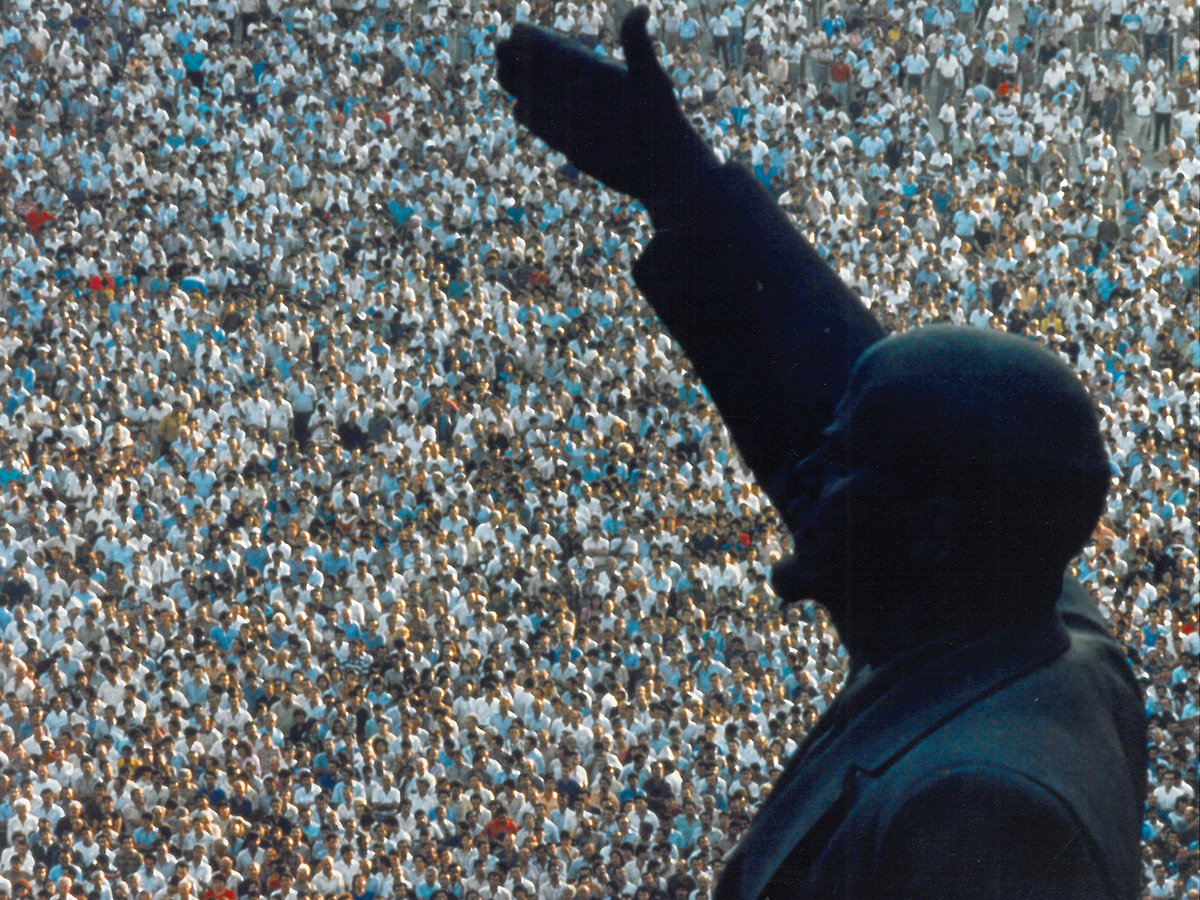
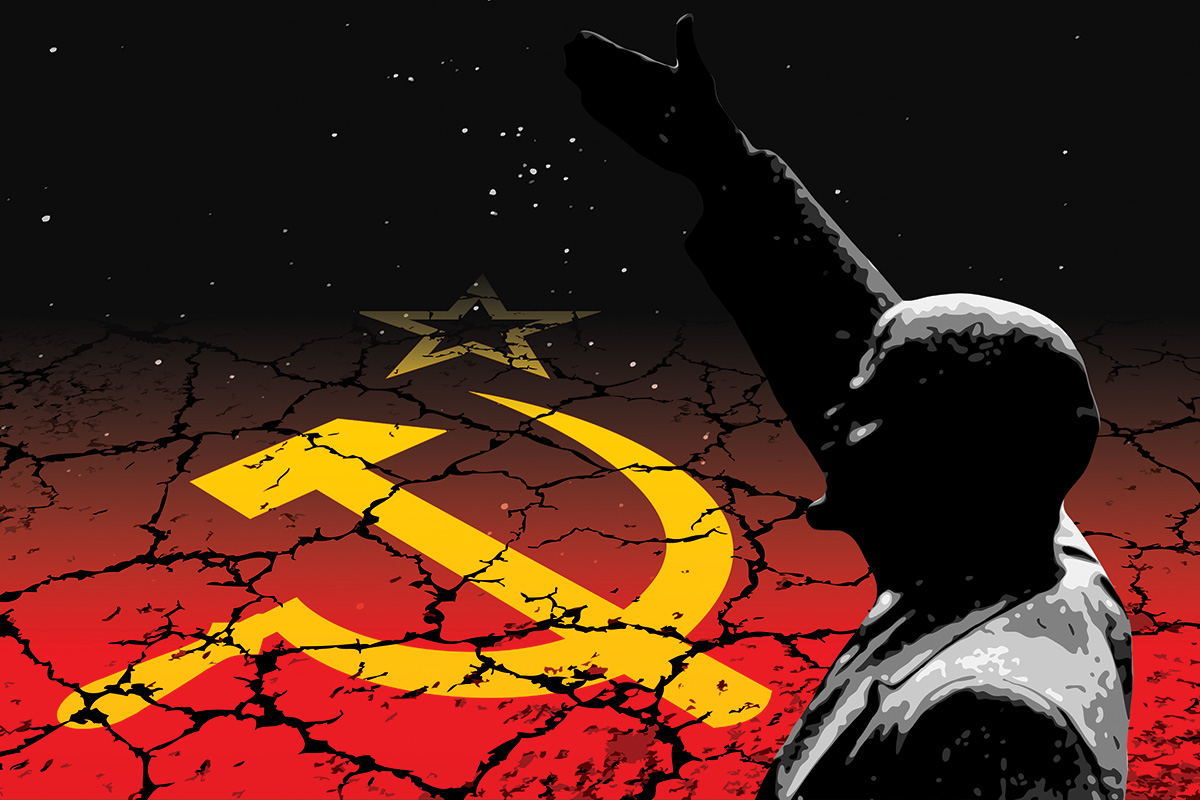
Vladimir Lenin’s commanding gesture over a sea of people (above top) was the basis for the cover design (above bottom) for The Foreign Service Journal’s special December 2011 issue, “When the USSR Fell: The Foreign Service on the Front Lines.”
Courtesy of Shawn Dorman and AFSA / Jeff Lau, respectively
Washington’s reluctance to accept the loss of the USSR was understandable. Since U.S. recognition of the Soviet regime in 1933, through the years of World War II and, most importantly, during the 44 years of the Cold War, the U.S.-Soviet relationship was the cornerstone of our foreign policy. It was the central foundation on which the postwar world was built. It defined our defense posture and our aspirations for a more peaceful world. Starting in the 1960s, the United States and our NATO allies determined to try to achieve peaceful coexistence with the Soviet Union. This went by many names, from the period of the first arms control agreements in the 1960s through Kissinger’s détente in the 1970s, and then the rapid de-escalation of confrontation once Gorbachev came to power.
There was a fundamental problem with key assumptions during this period. While it was clearly right to pursue arms control and reduce the risk of nuclear conflict, and while the expansion of people-to-people ties and exchange programs can only be described as positive, the fundamental assumptions we operated on during those years were wrong. One was that the Soviet Union was immutable: its existence was an unchangeable reality that we had to accept and come to terms with. Only a few “captive nations” organizations and hard-core Cold Warriors rejected this consensus.
The second was that most Soviet citizens accepted the USSR and their place in it despite horrific living standards and ongoing repression. How wrong this assumption was quickly became apparent as soon as the opportunity to leave or transform the USSR presented itself. The vast majority of the country headed for the exits—seemingly without regret at the time, although that assumption proved not quite correct in coming years.
The legitimacy of the Soviet Union rested on several shaky pillars. One was the fact that from the beginning, it was the product of a conspiracy by a minority to seize power from the majority. Not just in Russia, where the main goal was to overcome the peasant majority, but in the non-Russian republics, as well, where Soviet power focused on denying national aspirations and continuing tsarist colonial policies. The sheer brutality of the Soviet experience left very little room for legitimacy when things got shaky in the late 1980s. Nearly everyone had a grandparent or great uncle or aunt who had been shot or sent to a labor camp. Few were untouched by the horrific nature of the Soviet regime, and memories were long.
In Washington, however, there remained great reluctance to give up the stability and predictability of the U.S.-Soviet Cold War rivalry. When it finally did collapse, it was replaced by a brief period of euphoria and triumphalism that also caused problems further down the road. This was the period of Francis Fukuyama’s “The End of History,” of President George H. W. Bush’s “New World Order” and of the triumph of democracy and the Western way of life.
Looking back, it seems hard to imagine that we expected all the republics of the former USSR to immediately become full-fledged liberal democracies, but we really did. Our recognition of the new states of the former USSR was preconditioned on a set of commitments, in writing, to free elections, freedom of speech and the full panoply of liberal freedoms.
Great Expectations
That’s not how it turned out in much of the former Soviet space. And the United States under several administrations quickly came to accept that some of the former Soviet republics were not going to be democratic anytime soon, and that our interests in those countries— e.g., air bases for the Afghan war, balancing Russian domination—made it necessary to accept the reimposition of dictatorship, in some cases far more dictatorial than Gorbachev’s Soviet Union had been. We ended up accepting a double standard in which the European former republics of the USSR were expected to adhere to basic principles of democracy and human rights, while the Central Asian republics were not.
Our approach was by no means a complete failure, however, and in fact it can be argued that, overall, it was a success. Today, not only is there true democracy in the three Baltic states, but also something pretty close to it in Ukraine (the second most populous former republic after Russia), Georgia and maybe Moldova and Armenia. That’s seven out of 15—not great, but far from a washout. Ukraine’s struggle to define its own identity and to move toward being a true member of the democratic European family of nations continues to inspire, all the more so after the tragic events of 2014 and the continuing Russian occupation of Crimea and the eastern Donbass.
When I look back on those exciting years in which I was privileged to be both a witness and a minor player, what I remember most is the optimism. The belief that a page in history had been turned, and that the world was truly moving in “our” direction— that is, toward Western-oriented liberal democracy, with everything that came with it, from free elections to free media, from freedom of religion to national self-determination—was widespread.
Were we naïve to be so hopeful? On balance, I would say yes. But we were naïve in a good way: we really believed that freedom and peaceful coexistence were not only possible, but inevitable. And America in those years was still a dominant force and determining factor in nearly every crisis and every development across the globe. Things are more complicated now, and some of our hopes and aspirations clearly have crashed on the rocks of harder realities. U.S.-Russian relations, in particular, are a painful subject for those of us who have devoted so many years to seeing them develop in a positive way.
What I take from those heady days when everything seemed possible is the reminder that nothing is forever, that change can happen in a positive way, and that we have to keep working toward the goals we have set and believe in.
And I truly believe we are better off than we were in the 1980s, when the world seemed poised on the brink of nuclear conflict, and when the peoples of the Soviet bloc were trapped in what was truly a prison house of nations. We should recognize the progress that we have helped to make, and rededicate ourselves to the hard work that lies ahead in making our earlier dreams and aspirations come true.

